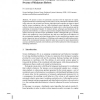Free Online Productivity Tools
i2Speak
i2Symbol
i2OCR
iTex2Img
iWeb2Print
iWeb2Shot
i2Type
iPdf2Split
iPdf2Merge
i2Bopomofo
i2Arabic
i2Style
i2Image
i2PDF
iLatex2Rtf
Sci2ools
ISER
2004
Springer
2004
Springer
Collective Inspection of Regular Structures using a Swarm of Miniature Robots
We present a series of experiments concerned with the inspection of regular, engineered structures carried out using swarms of five to twenty autonomous, miniature robots, solely endowed with on-board, local sensors. Individual robot controllers are behavior-based and the swarm coordination relies on a fully distributed control algorithm. The resulting collective behavior emerges from a combination of simple robot-to-robot interactions and the underlying environmental template. To estimate intrinsic advantages and limitations of the proposed control solution, we capture its characteristics at higher abstraction levels using nonspatial, microscopic and macroscopic probabilistic models. Although both types of models achieve only qualitatively correct predictions, they help us to shed light on the influence of the environmental template and control design choices on the considered non-spatial swarm metrics (inspection time and redundancy). Modeling results suggest that additional geomet...
| Added | 02 Jul 2010 |
| Updated | 02 Jul 2010 |
| Type | Conference |
| Year | 2004 |
| Where | ISER |
| Authors | Nikolaus Correll, Alcherio Martinoli |
Comments (0)

